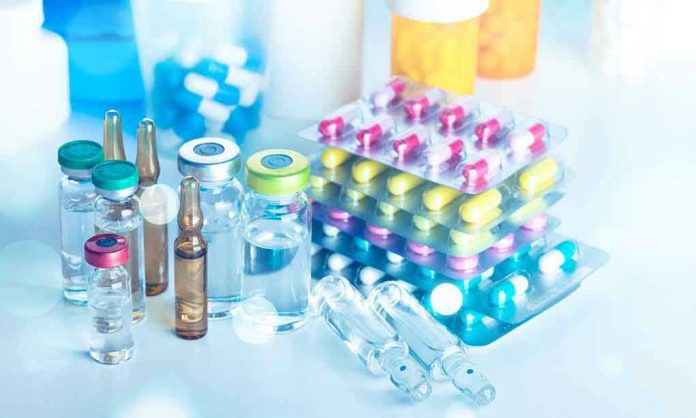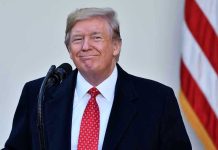
One moment of human vulnerability in the Oval Office upended an airtight White House event, exposing how even the most scripted political theater can become unexpectedly real—and unforgettable—for everyone watching.
Story Snapshot
- A pharmaceutical executive fainted live on camera during Trump’s Oval Office drug pricing event.
- The incident paused the high-stakes announcement for nearly an hour, drawing rare attention to the human side of policy spectacle.
- Swift medical intervention from Mehmet Oz and the White House team reassured guests and viewers as the event resumed.
- The administration’s handling of the moment was scrutinized just as heavily as the drug price deal itself.
An Unplanned Collapse in the Center of Power
Thirty minutes into a highly orchestrated White House announcement, a pharmaceutical executive standing behind President Trump crumpled to the floor. The event, meant to showcase a major deal to cut prices for weight-loss drugs, suddenly became about something no one could have predicted: a man’s health crisis played out before the nation’s cameras. The guest, later identified as Gordon from Eli Lilly, was there as a living symbol of industry cooperation, yet in a flash, he became the story. The room’s collective focus shifted from policy to person, as Mehmet Oz, administrator of the Centers for Medicare and Medicaid Services, leapt into action, summoning medical staff and upending the choreography of power. The press, ushered hastily out, left the American public staring at a screen gone dark, their curiosity now riveted by what had just unfolded.
For almost an hour, the usually untouchable Oval Office transformed into an emergency ward. White House medical personnel worked behind closed doors, and speculation ran wild across networks and social media. In that forced intermission, the event’s original headline—Trump’s triumph on drug prices—was overtaken by a very simple human question: Is he okay? When the doors finally reopened, President Trump and Eli Lilly CEO David Ricks addressed the incident head-on, dispelling rumors and offering reassurance. “He got a little bit light-headed… He’s fine. They just sent him out… He’s got doctors’ care. But he’s fine,” Trump announced, his tone measured. Ricks added, “Gordon was one of the Lilly guests at the White House today. He became faint… Pleased to say that the White House medical staff did a great job, and he’s doing great. So, nothing to be concerned about.” The message was clear: the show would go on, but the interruption would not be glossed over.
High Stakes and Higher Pressure: The Context Behind the Event
The November 7, 2025, Oval Office gathering was the culmination of months of wrangling between the Trump administration and major pharmaceutical companies. Public frustration over soaring drug prices had reached a boiling point, prompting the White House to pursue not just regulatory threats, but direct negotiation. Companies like Eli Lilly and Novo Nordisk faced pressure to lower prices for popular and profitable weight-loss drugs in exchange for relief from impending tariffs. The event was designed to be a victory lap: a rare instance of industry and government on the same stage, united by a common cause. Attendees, including the press and senior executives, stood for an extended period in the formal heat of the Oval Office—a setting that, for all its symbolism, can be physically unforgiving. While medical incidents at such high-profile gatherings are rare, the combination of stress, heat, and prolonged standing created the perfect storm for a public collapse.
Mehmet Oz’s response to the emergency became a footnote to the main narrative, but also a reminder that the machinery of government, for all its grandeur, depends on the quick thinking of individuals. The medical staff’s seamless intervention reassured Americans that, even in moments of chaos, competence prevails. Meanwhile, political observers dissected the administration’s response, noting Trump’s decision to pause rather than proceed, and the candor with which the incident was addressed. For a brief window, the priorities of statecraft took a back seat to the well-being of a single participant—a rare and relatable disruption in a setting engineered to avoid them.
What Remains: Policy, Perception, and the Power of the Unexpected
When the event finally resumed and the drug pricing deal was announced, the intended message was clear: the administration had delivered on a key promise. Yet, for many, the day would be remembered just as much for the moment the pageantry was pierced by reality. In the short term, the incident brought additional media scrutiny, not only on the health of the guest but on the administration’s crisis management and the optics of vulnerability in the halls of power. Longer term, the fainting itself faded from headlines, but the policy ramifications—reduced prices for in-demand weight-loss drugs—continued to ripple through the healthcare and pharmaceutical sectors.
Experts weighed in after the fact, noting that extended standing in warm, stressful environments is a well-known risk for fainting—a reminder that even the most seasoned executives can be caught off guard by biology. Medical professionals highlighted the importance of immediate care, while policy analysts returned focus to the substance of the drug deal. The administration’s transparent handling of the incident won cautious praise for prioritizing the guest’s health over optics. In American politics, where image is everything, such moments of unscripted humanity can forge unexpected connections—or, at the very least, disrupt the narrative long enough to remind viewers that power, for all its trappings, is wielded by people first and foremost.






